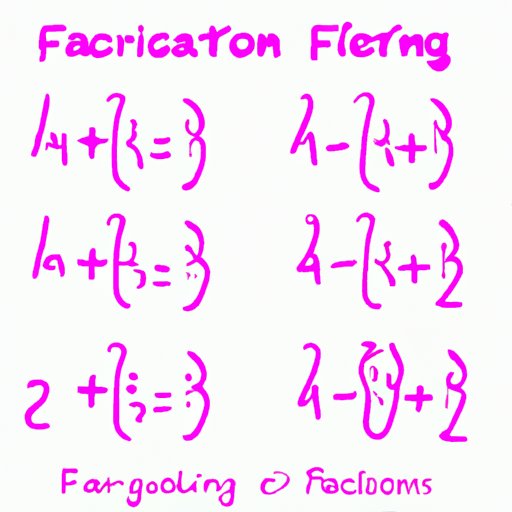
Introduction
If you’re a high school or college student taking algebra, you’ve probably encountered algebraic fractions, and they can seem a bit daunting. But fear not, as this guide will help you understand and master algebra with fractions. The target audience for this guide is students who are just starting to learn about fractions and algebra or anyone who wants to refresh their knowledge on algebraic fractions. Learning algebra with fractions is important because it helps you solve complex equations, which is essential in several industries, including engineering, sciences, and finance.
Simplify Algebraic Fractions: A Step-by-Step Guide for Beginners
Before diving into algebraic expressions with fractions, let’s first review basic operations with fractions. You’ll need to know addition, subtraction, multiplication, and division of fractions. For example, to add or subtract fractions, you need a common denominator. To multiply fractions, you simply multiply the numerators and the denominators. To divide fractions, you invert the second fraction and multiply it by the first.
To simplify algebraic expressions with fractions, apply the distributive property to both the numerator and the denominator. Factor out common terms and cancel out common factors. Another method is the cross-multiplication method, where you multiply each term in one numerator by the other denominator and vice versa, then simplify the resulting fractions. Remember to check your answer by plugging it back into the original equation.
To help you apply these methods, here are some practice problems:
Simplify the following algebraic fractions:
-
$\frac{2x}{4}$
-
$\frac{2}{x}+\frac{3}{x^2}$
-
$\frac{x}{2x+2} – \frac{1}{2x+2}$
-
$\frac{1}{x-2} -\frac{1}{x+2}$
Mastering Algebra with Fractions: Tips and Tricks
Now that you understand how to simplify algebraic fractions, let’s move on to more complex operations. Rules for adding, subtracting, multiplying, and dividing algebraic fractions are similar to the ones for numerical fractions. Remember to factorize as much as possible and perform the indicated operations before simplifying. Shortcut techniques include finding a common factor to simplify, converting mixed numbers to improper fractions, and using a common denominator. Strategies for simplifying complex algebraic expressions include breaking them down into smaller steps, grouping terms with common factors, and using the order of operations (PEMDAS).
To help you master these operations, here are some example problems:
Solve the following algebraic problems:
-
$\frac{1}{x-3} +\frac{2}{3-x}$
-
$\frac{2}{x-5} -\frac{3}{x+1}$
-
${(\frac{2}{x} – \frac{1}{y})}{(\frac{y}{x} + \frac{1}{y})}$
-
${\frac{x^2-2x-3}{x-3}}+{\frac{2x-4}{x-3}}$
Solving Complex Algebraic Equations with Fractional Coefficients
Equations with fractional coefficients may seem intimidating, but with practice, you can solve them with ease. Understanding fractional coefficients is key, and you can simplify by multiplying each term by the common denominator of the fractions. Then, apply the order of operations, simplify the equation, and isolate the variable you need to solve for. If there are variables on both sides of the equation, cancel them out and solve for the remaining variable.
Let’s apply these techniques to the following practice problems:
-
$\frac{4}{3}x – \frac{1}{5} = \frac{3}{2}x + 4$
-
${\frac{1}{x-3}} + {\frac{1}{x+1}} = {\frac{2}{x-1}}$
-
${\frac{3}{x-2}}-{\frac{2}{x+3}}={\frac{10}{(x-2)(x+3)}}$
-
${\frac{4}{x}}+{\frac{2}{3x}}=5$
Common Mistakes to Avoid When Doing Algebra with Fractions
Even experts make mistakes, so don’t be discouraged if you encounter difficulties when working with algebraic fractions. Common mistakes include not finding a common denominator, forgetting to simplify, confusing the sign between the numerator and the denominator, and not following the order of operations.
To avoid these mistakes, practice regularly, check your work, and simplify as much as possible before performing any operations. Here are some test problems to help you avoid common mistakes:
-
${\frac{3} {x+1}} +{\frac{2}{x-1}}={\frac{5}{x^2+x-2}}$
-
${\frac{2}{5x}} +{\frac{1}{2x^2}}={\frac{11}{10x}}$
-
${\frac{x+1}{x-7}} – {\frac{x-7}{x+1}} = 4$
-
${\frac{1}{x+1}} + {\frac{1}{x^2-1}} = {\frac{2x}{x^2-1}}$
Real-World Application of Algebraic Fractions in Problem Solving
Algebra with fractions is used in real-world problem-solving in several fields, from engineering and physics to finance and medicine. For example, calculating medication dosages involves converting proportions of compounds into fractions in a prescribed dose. Budgeting and financial planning also use algebra with fractions to calculate incomes, expenses, and investments. Let’s apply these concepts to the following industry examples:
-
A pharmaceutical company wants to manufacture a drug in amounts of ${\frac{1}{16}}$, ${\frac{1}{8}}$, ${\frac{3}{16}}$, and ${\frac{1}{4}}$ parts of four different chemicals. What’s the smallest amount of each chemical that the company can order to manufacture a certain quantity of the drug?
-
A marketing agency budgets ${\frac{1}{5}}$ of their revenue for advertising on social media and ${\frac{1}{10}}$ for traditional media. If the agency has a revenue of $500,000, how much do they spend on each type of media?
-
Calculate the displacement and velocity of an object traveling with an acceleration of ${\frac{5}{12}}m/s^2$, an initial velocity of ${\frac{1}{4}}m/s$, and a displacement of ${\frac{1}{6}}m$.
-
A contractor needs ${\frac{5}{8}}$ meters of electrical tape per light bulb. How many light bulbs can be fixed using 150 meters of electrical tape?
Algebra with Fractions: From Basic Operations to Advanced Concepts
Now that you’ve learned the basics of algebra with fractions, you’re ready to tackle more advanced concepts. These include solving quadratic equations, graphing hyperbolas and parabolas, simplifying rational functions, and solving systems of equations. In this section, we’ve reviewed the topics covered in this guide, and included a final practice exercise to test your knowledge of algebra with fractions:
-
Simplify the following fractions:
a. ${\frac{a}{2}} + {\frac{b}{3}}$
b. ${\frac{2}{x}} \cdot {\frac{3x}{2}}$
c. $({\frac{1}{x}}-{\frac{1}{y}}) \cdot {\frac{x}{y}}$
-
Solve the following equations:
a. $3{\frac{x}{2}} +2(x-{\frac{x+3}{4}}) = x+1$
b. $({\frac{1}{x}}-{\frac{1}{y}}) = {\frac{1}{z}}$
c. $5({\frac{1}{x}} – {\frac{1}{2}}) = {\frac{2}{x}}$
Closing Thoughts
Algebra with fractions may seem overwhelming, but with practice, you can easily solve complex equations and apply algebraic fractions in real-world problem-solving. Remember to check your work, simplify before performing operations, and practice regularly. Further resources for learning algebra with fractions include online courses, textbooks, and tutoring services.





